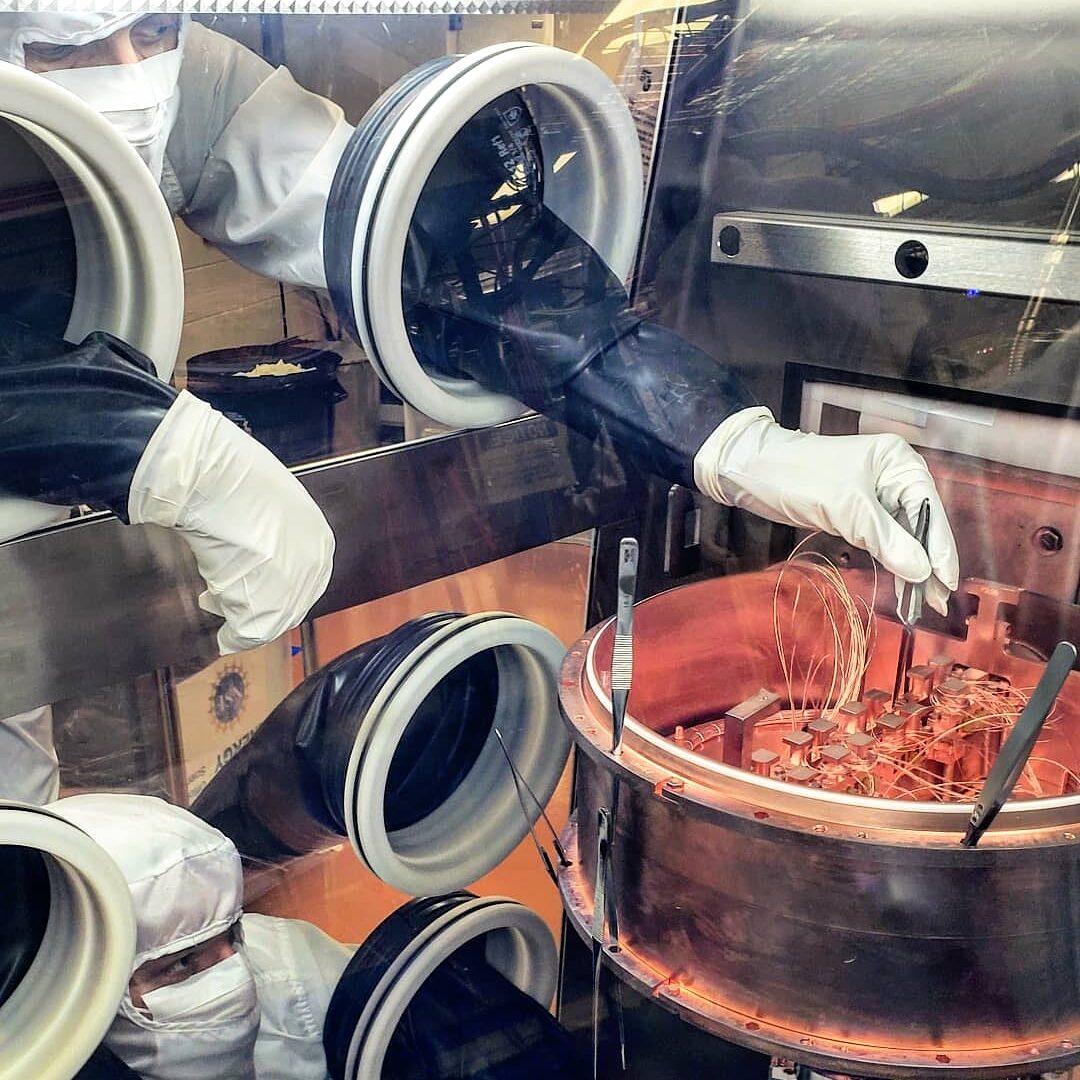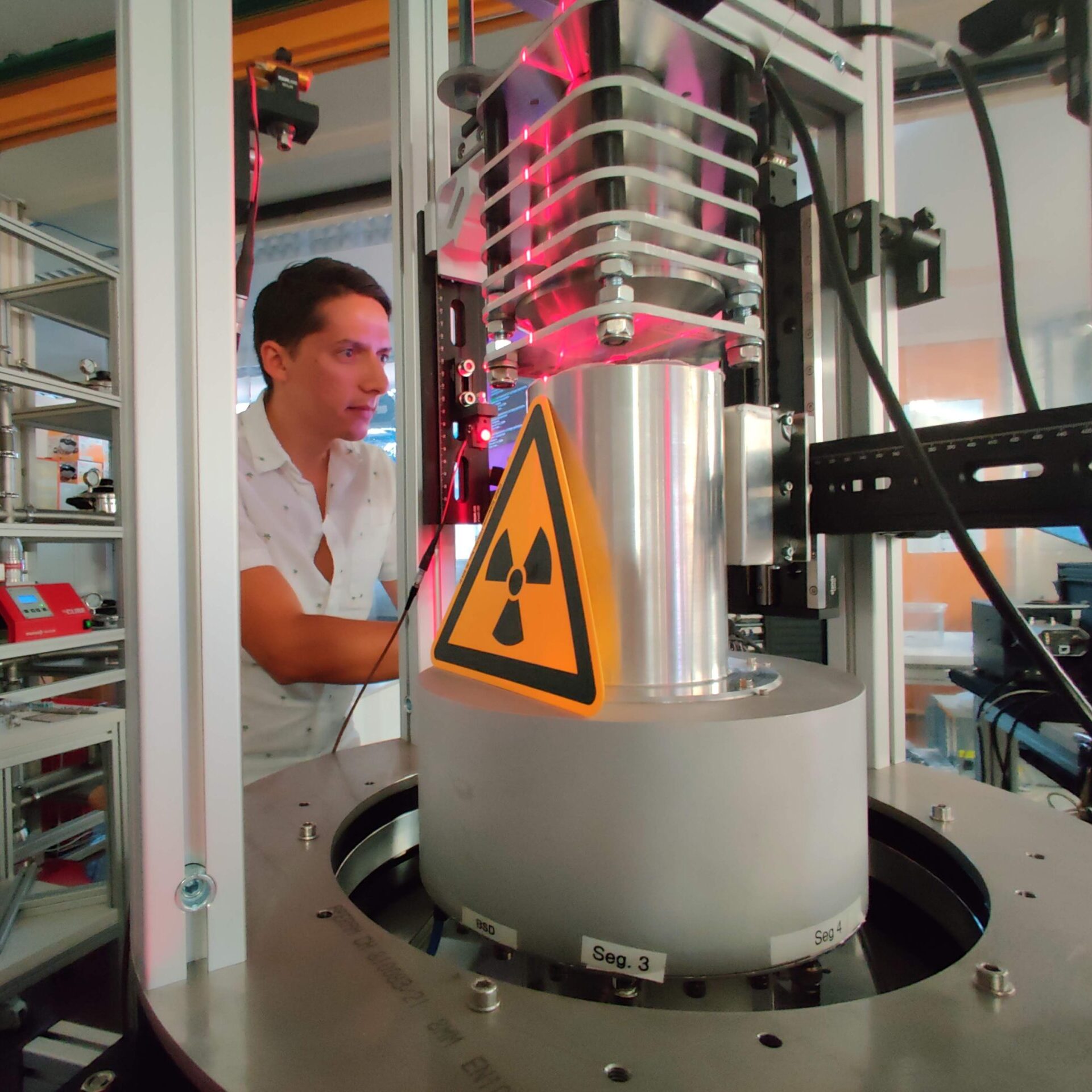
Ionizing radiation hits random locations on a germanium detector producing electron-hole pairs in the lattice. Electrons and holes drift in opposite directions in an electric field which strength is indicated by color. Each second on screen corresponds to 60 ns in simulation.
Electric field and drift paths calculated by SolidStateDetectors software. Plotting code – in Julia, animation, and design by David Hervas Aguilar.
Double-Beta decay (2νββ) is a second order electro-weak process and, thus, much rarer than the well known single-beta decay. Single-beta decay is not energetically allowed in certain even-even nuclei; however, in such nuclei 2νββ can be observed. Two beta decays occur simultaneously, resulting in the emission of two electrons and two electron anti-neutrinos. It took 52 years from when Maria Goeppert-Mayer first postulated 2νββ in 1935, until it was first observed in 82Se. This process has now been observed in various naturally existing isotopes with half–lives above 1018 years. The observation of even rarer decays is now within grasp with advances in low background measurement techniques. If neutrinos are Majorana particles, an even rarer event – neutrinoless double-beta decay (0νββ) – can occur.
As opposed to 2νββ, no anti-neutrinos would be emitted, thus violating lepton number conservation. Therefore, the two electrons carry away all the energy of the decay, producing a peak at the end of the broad 2νββ summed electron energy spectrum. This mono-energetic peak is the key experimental signature of 0νββ. The anti-neutrinos are exchanged as a virtual particle in the nucleus, via light Majorana neutrino exchange. More exotic mechanisms for 0νββ have been proposed; nevertheless, regardless of the mechanism, the observation of such a phenomenon would imply that neutrinos are Majorana particles, and as such, they constitute their own antiparticles.
The observation of neutrinoless double-beta decay (0νββ) would shed light on many of the fundamental questions in physics, including lepton number conservation, matter-antimatter asymmetry in the universe, and the nature of the neutrino itself.
My work on 0νββ encompasses a multidisciplinary approach involving software, electronics, and hardware. As a member of the MAJORANA and LEGEND collaborations, my research advances the search for 0νββ in 76Ge using High Purity Germanium (HPGe) detectors. 76Ge has long been at the forefront of the search for 0νββ. The technology has set some of the best limits on half-life of 0νββ to date as demonstrated by the MAJORANA DEMONSTRATOR and the Germanium Detector Array (GERDA). Ge detectors have long been a standard in the field of nuclear and particle physics and are very well posed for this search.
The Large Enriched Germanium Experiment for Neutrinoless Double-Beta Decay (0νββ) (LEGEND) will combine the best techniques from the MAJORANA DEMONSTRATOR and GERDA to search for 0νββ in 76Ge. The LEGEND collaboration is pursuing a phased approach to a ton-scale 76Ge experiment, with ultimate discovery potential at a half–life beyond 1028 years. The first phase, LEGEND-200, is the deployment of 200 kg of enriched 76Ge detectors in the GERDA cryostat at the LNGS underground laboratory in Italy.
My work in the MAJORANA DEMONSTRATOR has included designing the pile-up cut and building a Monte Carlo uncertainty propagation framework for the DEMONSTRATOR‘s assay-based background model. Additionally, I was heavily involved in the DEMONSTRATOR‘s Cable and Connector Upgrade, from its R&D stage to eventual completion in 2020. This work is informing R&D for LEGEND. My current focus is on the novel HPGe Compton Scanner I built in collaboration with a team at the Max Planck Institute for Physics in Munich. The device will be used to study signals in a LEGEND style HPGe detector.

David Hervas Aguilar (top) and Dr. Ralph Massarczyk (bottom) working on the Cable and Connector Upgrade of the MAJORANA DEMONTRATOR at the Sanford Underground Research Facility.
Lead, SD, USA, January 17, 2020

Working on a novel HPGe Compton scanner at the Max Planck Institute for Physics in Munich. The principle of operation of a Compton scanner is the same as a conventional camera. By capturing light – or in our case gamma rays – scattering off a subject, an image is reconstructed.
Munich, Germany, July 24, 2019

Seeing sunlight for the first time in a week, we emerge from the 4850′ level of the Sanford Underground Research Facility after a rewarding day of work on the MAJORANA DEMONTRATOR.
Lead, SD, USA, January 22, 2020